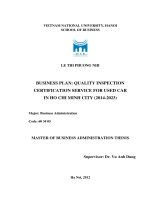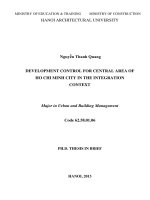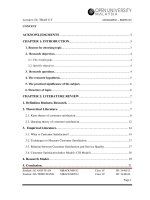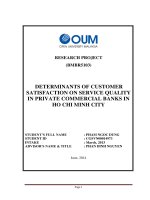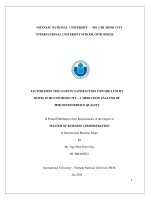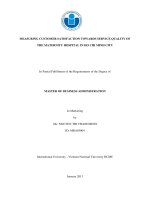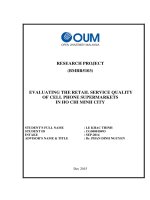business plan quality inspection certification service for used car in ho chi minh city (2014 2023) Kế hoạch kinh doanh dịch vụ và chứng nhận chất lượng xe ô tô đã qua sử dụng tại thành phố Hồ Chí Minh (20142023)
Bạn đang xem bản rút gọn của tài liệu. Xem và tải ngay bản đầy đủ của tài liệu tại đây (2.32 MB, 98 trang )
VIETNAM NATIONAL UNIVERSITY, HANOI
SCHOOL OF BUSINESS
LE THI PHUONG NHI
BUSINESS PLAN: QUALITY INSPECTION
CERTIFICATION SERVICE FOR USED CAR
IN HO CHI MINH CITY (2014-2023)
Major: Business Administration
Code: 60 34 05
MASTER OF BUSINESS ADMINISTRATION THESIS
Supervisor: Dr. Vu Anh Dung
Ha Noi, 2012
vii
TABLE OF CONTENTS
ACKNOWLEDGEMENTS i
ABSTRACT iii
TABLE OF CONTENTS vii
LIST OF ABBREVIATIONS x
LIST OF TABLES xi
LIST OF FIGURES xiii
LIST OF CHARTS xiv
INTRODUCTION 1
Research Rationale 1
Problem identification 2
Research Objectives 3
Scope & Limitation of the thesis 3
Research Methodology 3
Structure of the Research 4
CHAPTER 1: LITERATUAL REVIEW OF A BUSINESS PLAN 5
1.1. What is Business Planning? 5
1.2. What is a Business Plan? 5
1.3. The importance of a Business Plan 5
1.4. What are the key aspects of a Business Plan? 6
CHAPTER 2: BUSINESS PLAN OF UCC COMPANY 16
2.1. OVERVIEW OF THE COMPANY 16
2.1.1. Introduction 16
2.1.2. Vision and Mission 16
2.1.3. Current status and key milestones of the company in near term
(2013-2014) 17
viii
2.2. INTRODUCTION OF THE SERVICE - USED CAR QUALITY
INSPECTION CERTIFICATION 18
2.2.1. Description 18
2.2.2. Why used-car quality certificate? 19
2.2.3. Who will use this service? 21
2.2.4. How to gain trust? 22
2.2.5. Business Model of Used-car Quality Certification service 23
2.3. MARKET ANALYSIS 23
2.3.1. Target customers 23
2.3.2. Market identification and segmentation 24
2.3.3. Competition Analysis 28
2.4. MARKETING ACTIVITIES 31
2.4.1. Service’s substitutes? 31
2.4.2. Pricing 31
2.4.3. Promotion and Brand Development 32
2.4.4. Marketing budget planning 37
2.5. DEVELOPING SALES CHANNELS 38
2.5.1. Direct sales team 39
2.5.2. Strategic sales distributors 41
2.6. MANUFACTURING PLAN 42
2.6.1. Licensed with top used-car certification service company 42
2.6.2. Service procedures 42
2.6.3. Facilities and Equipment required 46
2.7. DEVELOPING HUMAN RESOURCE AND MANAGEMENT 52
2.7.1. Funtional and organizational structure 52
2.7.2. Headcount planning 55
2.7.3. Recruitment and Training 56
2.7.4. Salary and bonus scheme 57
2.8. FINANCIAL ANALYSIS AND PROJECTION 58
2.8.1. Assumption 58
ix
2.8.2. Cost calculation and funding plan 62
2.8.3. Revenue Projection 64
2.8.4. Profit and Loss (P&L) Forecast 66
2.8.4. Cash Flow Analysis 68
2.8.5. Sensitivity Analysis 70
CONCLUSION AND RECOMMENDATION 77
REFERENCES 79
APPENDIX 1: Sample of Inspection Report 81
APPENDIX 2: Cost Projection (2014 – 2023) 84
APPENDIX 3: Capital Funding Structure 87
x
LIST OF ABBREVIATIONS
HCM Ho Chi Minh
IRR Internal Rate of Return
NPV Net Present Value
UCC Used Car Certificate
WACC Weighted Average Cost of Capital
xi
LIST OF TABLES
Table 2.1. Some key miletones at the start (2013 – 2014) 17
Table 2.2. Summary of some key figures of cars market in HCMC 25
Table 2.3. Cost break-down projection of marketing activities in 2014 38
Table 2.4. Number of sales headcounts in 2014-2023 39
Table 2.5. Monthly sales target for sales team and individuals (2014) 40
Table 2.6. Bonus scheme for ―sales center‖ 41
Table 2.7. Decision No. 14/2012/QD UBND regarding Percentage of Land
Rental Pricing (Clause 1.1.b) 48
Table 2.8. Technical equipments required 50
Table 2.9. Office equipments and furniture 52
Table 2.10. Scope of work of functional divisions 53
Table 2.11. Headcount plan (2014 – 2023) 55
Table 2.12. Base salary scheme for key accounts (2014) 57
Table 2.13. Financial Assumptions 58
Table 2.14. Assumption on basic fixed cost 59
Table 2.15. Assumptions on cost associated with manpower 61
Table 2.16. Assumptions on other operations fee and contingency fee 61
Table 2.17.Cost of the first 3 years (2013-2015) 62
Table 2.18. Capital funding plan 63
Table 2.19. Revenue Projection (2014-2023) 64
Table 2.20. Productivity management and Sales target (2014-2023) 65
Table 2.21. Projected Profit and Lost (2014-2023) 66
Table 2.22. Analysis of cash flow, NPV, IRR and break-even time 68
Table 2.23. Sensitive analysis of IRR vs. Construction Unit Price and Sales Price 70
Table 2.24. Sensitive analysis of IRR vs. Annual Salary Growth Rate and
Sales Price 72
xii
Table 2.25. Sensitive analysis of NPV vs. Annual Salary Growth Rate and
Sales Price 74
Table 2.26. Sensitive analysis of IRR vs. Annual Salary Growth Rate and
Sales Price 75
xiii
LIST OF FIGURES
Figure 2.1 : Business model of used car quality inspection certification 23
Figure 2.2: Customer Engagement Cycle 33
Figure 2.3: SK ENCAR’s home site 36
Figure 2.4. Key steps of service procedures 43
Figure 2.5. Car status report format 44
Figure 2.6. The value chain of used car quality certification service 46
Figure 2.7. Organization structure (2014) 54
xiv
LIST OF CHARTS
Chart 2.1. Sensitive analysis of IRR vs. Sales price and Construction Unit Price 71
Chart 2.2. Sensitive analysis of IRR vs. Sales price and Annual Salary Growth 73
Chart 2.3. Sensitive analysis of NPV vs. Sales price and Annual Salary Growth 74
Chart 2.4. Sensitive analysis of IRR vs. Licensing cost and Sales price 76
iii
ABSTRACT
BUSINESS PLAN: QUALITY INSPECTION CERTIFICATION
SERVICE FOR USED CAR IN HO CHI MINH CITY (2014 – 2023)
Le Thi Phuong Nhi
MBA Candidate, 2007-2019
School of Business
Vietnam National University, Hanoi
Supervisor: Dr. Vu Anh Dung
December 2012, 86 pages
Taking the development trend of developed countries as well as emerging
markets in Asia as a benchmark, it is no doubt that motorbikes will be
constantly replaced by cars and public transportation towards the
development of the socio-economy of the nation.
The Vietnam’s car market, with its recent increase in demand and supply
regardless of economics down-turn, also re-emphasize this trend. Going in
parallel with this development is the business transactions of used-cars. And
one of the key concerns when people buy used car is the reflection of the true
value and the true picture of its quality behind while the sellers tends to hide
the defects or damages of the car. Therefore, used-car quality inspection
service provider as a reliable third-party can help connecting the buyers and
sellers via TRUST and, more importantly, to reduce unexpected accidents/
damages due to insufficient understanding or mistakes on the quality of the
used car.
The idea of used car qualily inspection certification service comes from the
demand of using good-quality used car. So far there is no one in Vietnam
provides this service yet. Used Car Certificate (UCC) Company will be set up
in Q4-2013 to service this untapped market demand. And it is critical to have
iv
a business plan with which serves as an essential roadmap for UCC to break
into the target market in near term, gain sustainable foundation for business
success in the next 10 years (2014 – 2023) and earn good return on
investment.
In order to work out the business plan for UCC in the period of 2014-2023,
the author has studied and summarized the literature review of business plan,
analyzed the market of this service, worked out the sales and marketing plan,
manufacturing and human resource planning and management, as well as
financial analysis and projection.
The analyzed statistics are collected from a number of sources. The primary
data is gathered from the Department of Transportation and Police of Ho Chi
Minh and the Ministry of Transportation. One of the major sources of primary
data is also from the interview using qualitative research methodology with
target end-users and key auto-dealers in Ho Chi Minh. On the other hand, the
secondary data is collected and enquired from reports of top used car quality
inspection certification service provider and from the internet.
The thesis serves as a roadmap for UCC to penetrate in the Vietnam’s used-car
market and position itself as a pioneer in the market. The study has figured out a
positive financial figures and ratio based on key aspects of the business. Hence,
this is a feasible business plan which is worth to pursue and invest.
1
INTRODUCTION
Research Rationale
Taking the development trend of developed countries (US, Japan, NATO
countries, etc.) as well as emerging markets in Asia (such as Singapore, South
Korea, China, Malaysia, etc.) as a benchmark, it is no doubt that motorbikes
will be constantly replaced by cars and public transportation.
Talking about the Vietnam’s car market, its recent increase in demand and
supply regardless of economics down-turn also re-emphasize this trend. And
the development of the car market will lead to the growth of both new car and
used-car market segment, which are always in parallel.
Reference to the successful business model of used-car quality investigation
service in developed countries (US, Europe, Korea, Japan, etc), this demand
is driven by the development of the car market. And it is in fact that used car
market in Vietnam is still at a very early stage with no centralized and trusted
hub of transaction. Most buyers do not know how to identify whether a used
car is still in good condition and how much % of quality remaining? Hence
most of them will rely on recommendations from their relationships. Some
people will search on Internet or advertisements, and then ask their friends
who are knowledgable enough about car to help identify its quality.
It is also important to note down that one of the key concerns when people
buy used car is the reflection of the true value and the true picture of its
quality behind while the sellers tends to hide the defects or damages of the
car. Therefore, used-car quality inspection service as a reliable third-party can
help connecting the buyers and sellers via TRUST and, more importantly, to
reduce unexpected accidents/ damages due to insufficient understanding or
mistakes on the quality of the used car.
2
Problem identification
Since the car sellers tend to hide defects or damages of the car, most of the
buyers do not trust the sellers if they don’t have any connections/
relationships with them. In other words, identifying the current status and
quality of the used car is important to the buyers. With a trusted car quality
investigation service, bow the buyers are able to qualify the used car before
before making decision on a considerable deal in terms of value, and more
importantly safety requirement. To a broader view, it also helps to avoid
unexpected accident/damages due to insufficient understanding or mistakes
on the true quality of the used car and its components’ replacement
requirements.
Towards such a fact, from business perspectives, there are two key issues that
need to be addressed. Firstly, there is a need of having a third-party who is
capable and reputable to certify on the quality of used car. As foresaid, this
can help the buyers and sellers gain more confidence on each other. Secondly,
there is a need of an effective online used-car market where buyers and sellers
can easily find each other and trust each other via a network of used-cars
which are certified in terms of origin and quality.
From social perspectives, it is important to note that the project Quality
Inspection Certification of Used-car helps prevent unexpected accidents due
to improper understanding on the real quality of the car and its components’
replacement requirements.
In conclusion, I firmly believe the project will add a considerable value to the
sustainable development of the car market in Vietnam in particular, and the
socio-economy in general.
3
Research Objectives
To develop a strategic business plan as an entreprenership project, which is
feasible and profitable, based on sufficient and reliable business plan and
implementation, feasibility study, sensitive analysis and risk management.
Project Objectives
The purposes of this research is to build up a feasible plan for a sustainable
network of used car quality inspection certification service in Ho Chi Minh,
targeting 3 centers in 2018.
Scope & Limitation of the thesis
- Target market: The project will focus in Ho Chi Minh city first, which
is the most potential market for this kind of service in Vietnam. The project
can be developed further with expansion to key cities in Vietnam (Ha Noi,
Hai Phong, Da Nang, Binh Duong, Dong Nai, Can Tho) to cover the entire
market of Vietnam. In long term, the project can be formulated to Laos and
Cambodia based on competitive advantage of the Vietnam’s presence.
However, considering Ho Chi Minh as the key and also most potential
market, within the scope of this project, Ho Chi Minh is taken as the primary
focus and to paive for the expansion plan in the future which can be studied
and executed separately and in parallel with this project.
- The quality inspection certification service is limited for cars only.
- Time frame: in 10 years (2014 – 2023)
Research Methodology
- Statistical analysis
- Systematic analysis
- Benchmarking
- Qualitative research via in-depth interviews with experts in car
industry and potential customers of this project.
4
o Target audience: those who are decision-makers on buying
used cars and those who are car dealers in Ho Chi Minh City.
o Sample size: 10 in-depth interviews
o Response rate: 100%
o Interview method: face-to-face/ site visit
o Expected Outcomes:
Pain-points when finding a good used car
Significant criteria when choosing a used car
Price sensitiveness
Structure of the Research
The research includes two chapters as follows:
Chapter 1: THEORATICAL OF BUSINESS PLANNING
This Chapter introduces key steps of a business plan which sets the
foundation and structure of the following chapter on business planning of
used car quality inspection certification service.
Chapter 2: BUSINESS PLAN OF USED CAR QUALITY INSPECTION
CERTIFICATION SERVICE
This Chapter develops a strategic business plan for this typical
entrepreneurship project – the used car quality inspection certification service,
which includes:
- Section 2.1: Overview of the company
- Section 2.2: Introduction of the service
- Section 2.3: Market analysis
- Section 2.4: Marketing plan
- Section 2.5: Developing sales channels
- Section 2.6: Manufacturing plan
- Section 2.7: Human resource planning and management
- Section 2.8: Financial analysis and projection
5
CHAPTER 1: LITERATUAL REVIEW OF A BUSINESS PLAN
1.1. What is Business Planning?
Business planning is thinking and working out the details of your enterprise
with the hope that you will be able to prevent problems, improve your
business and thus earn more profit. Engaging in planning helps you to analyse
your potential for success. Planning also enables you to identify what you will
need to do on your way towards having a successful business [1].
1.2. What is a Business Plan?
A business plan is a tool which helps entrepreneurs to plan their businesses. It
is a written summary that describes important aspects of the business [1]
which serves as an essential roadmap for business success. The plan works for
a business to look ahead, allocate resources, focus on key points, and prepare
for problems and opportunities [2].
Business plans may also target changes in perception and branding by the
customer, client, taxpayer, or larger community. When the existing business
is to assume a major change or when planning a new venture, a 3 to 5 year
business plan is required, since investors will look for their annual return in
that timeframe.
A simple startup plan includes a summary, mission statement, keys to
success, market analysis, and break-even analysis. This kind of plan is good
for deciding whether or not to proceed with a plan, to tell if there is a business
worth pursuing, but it is not enough to run a business with.
1.3. The importance of a Business Plan
A Business Plan helps to [1]:
* Prevent mistakes
* Identify strengths and weaknesses/challenges
6
* Spot and correct errors before they occur * Communicate your ideas to
investors and lenders
* Clarify your product or service
* Establish the break even point of the business and prepare cash flow
forecasts
* Identify any other requirements or needs such as training and finance
* Identify objectives for the upcoming year
* Reveal the timing and location of business development
* Guide the start up of the business
* Evaluate the progress of the business
* Build the entrepreneur’s confidence
* Redirect the entrepreneur to new and or better ideas
* Identify potential customers and strategies to communicate with them
1.4. What are the key aspects of a Business Plan?
Business Plans may differ in the sections that are included. However, there
are some general sections that are required. These include [1, 2, 3, 4]:
- An Executive summary: This is a summary of the information included in
the business plan.
- Company Description: Legal establishment, history, start-up plans, etc.
- Description of the Product/Service: Describe what you are selling. Focus on
customer benefits
- Market Analysis: You need to know your market, customer needs, where
they are, how to reach them, etc.
- Developing Marketing activities: Includes an outline of the marketing plan
and information on competitors.
- Developing Sales team: Includes an outline of the type of sales person that
you need, how you structure the team and develop them.
7
- Operations planning: A strategic plan time tabling business activities, how
and when these would be carried out.
- Financial Management & Projection: Outlines profit and loss, cash flow,
balance sheet, break-even analysis, assumptions, business ratios, etc.
- Conclusion: May be used to express reservations about the business idea,
amount of finance required, etc.
To a complete and thorough view, a business plan should aim to have the
following sections.
1.4.1. Executive summary
The executive summary summarizes the key points of the business plan. It
should define the decision to be made and the reasons for approval. The
specific content will be highly dependent on the core purpose and target
audience. To get a sense of the difference the purpose and target audience can
make, here are three different sets of key points for an executive summary -
one for a loan request, one for a start-up seeking venture finance, and one for
an internal plan:
A loan request executive summary might contain the following information:
Company information: name of company, years in business, legal
structure, minority and majority owners
Brief description of project
Amount and length of loan
Objective reasons why the bank should be confident that the loan will
be paid back. This likely will include
o Financial track record
o The future revenue stream
o Any contracts in place that might guarantee the revenue stream is
more than just a forecast.
8
For a new venture, the executive summary might contain:
Company information: name of company, proposed legal structure,
current legal structure, minority and majority investors.
Amount of investment requested
Expected terminal value
Description of market opportunity
Objective reasons why the market opportunity can be exploited by this
particular team
For an internal project plan, the executive summary might look like this:
Company information: not applicable
Description of project
Project mandate: who requested the proposal, who is being assigned to
carry it out
Strategic, tactical and financial justifications
Summary of resources needed: staff, funds, facilities
In some cases information will overlap. For example, some of the reasons
why a loan is likely to be repaid might equally as well be used as justification
for the kind of extraordinary return expected by venture capitalists.
In some cases the business plan as a whole contains similar information, but
for one type of plan it is mere detail and for another it is a key decision
making factor. For instance, both start-ups and internal projects need staff and
facilities. However the staffing and facilities needs are considered details in a
plan for start-up financing. In a plan for internal projects they are key
elements and, in fact, may be the only resources needed.
1.4.2. Organizational background
In a written plan, information may appear in a separate section, an appendix,
or may be omitted all together depending on the nature of the plan. If the plan
9
is directed at people outside of the company, a brief synopsis may appear in
the executive summary. This will be supplemented with a more detailed
discussion elsewhere in the plan.
a. Current status
Number of Employees
Annual sales figures (if it is a business plan for an on-going business)
Key product lines
Location of facilities
Current stage of development (start-ups)
Corporate structure: Options are Sole proprietors; Partnership; Joint
Venture; Publicly traded corporation; Private corporation; Limited
liability company; Public utility; Non-profit organization;
Cooperatives.
Names of the majority investor, if any
b. History:
Founding date
Major successes
Strategically valuable learning experiences
c. Management team
Board members
Owners
Senior managers
1.4.3. Marketing plan
The marketing plan has five objectives:
a. Substitute identification:
10
If the product is a new product with no existing market, one must
identify all substitute products. For each significant substitute product
one must explain:
Name, features, why substitute, why proposed product better
Switching costs and why new product justifies switching
Expected adoption dynamics
Expected role once market begins to develop (see above for existing
products)
b. Pricing
Chosen Price points
Proposed Pricing strategy
c. Demand management
In economics, demand management is the art or science of controlling
economic demand to avoid a recession. The term is also used to refer to
management of the distribution of, and access to goods and services on the
basic of needs. An example is social security and welfare services. Rather
than increasing budgets for these things, governments may develop policies
that allocate existing resources according to a hierarchy of need.
d. Distribution/Positioning
Distribution strategy
List of major distributors
Current status of negotiations
e. Promotion and brand development
Promotion strategy
1.4.4. Operational plan
The plan outlines how one would service their clients cost effectively.
a. Manufacturing/deployment plan
11
Supply chain requirements
Production inputs
Facility requirements - size, layout, capacity, location
Equipment requirements
Warehousing needs for raw materials, finished goods
o Space requirements
b. Information and communications technology plan
Systems needed
o Operations: Billing, HR, SCM, CRM, Knowledge bases, etc.
o Websites: internal, public
Security and privacy requirements
Hardware requirements
Off-the-shelf software needed
Custom development requirements
c. Staffing needs
List of roles
Management structure
Head count approval
For each role
o Job descriptions
o Number of employees
o Proposed compensation
o Availability
Training plan
d. Training requirements
Training requirements should look to address two issues - a benefit to
motivate staff and developing the capability of the organisation to deliver the
12
business objectives. Ideally all training requirements should be based on as an
assessment of the business plan objectives, the required competence and
capability to deliver these objectives and understanding of the current
capacity and capability of the organisation. Simple question to ask to assess
the appropriateness of the training - as a result of the training how much
better will the organization be at delivering its objectives. Remember that
training covers a wide range of activities from project work and on the job
training to professional qualifications. Most learning takes place outside of
formal training activities.
e. Intellectual property plan
Intellectual property inventory
Portfolio development plan
f. Acquisition plan
Some business plans gain competitive advantage by buying companies up and
down the value chain. Some gain competitive advantage by buying up
companies and consolidating them. Sometimes a business plan will seek to
earn a superior return by adding superior management talent to an existing
weak company.
When acquisitions form a major part of the business strategy, the acquisition
plan needs to be included in the business plan.
Acquisition strategy
Proposed acquisition targets
Effect on market structure (if consolidation plan is being proposed)
g. Organizational learning plan
The organizational learning plan discusses what lessons will be learned from
the marketing, operational, and finance plans and how those lessons will be
consolidated to gain strategic advantage.
13
Market sensing - organization's method for collecting information
about customers (George Day)
Strategic Staircase - the accumulation of future competencies by
building on existing competencies. (Michael Hays, Costas Markides)
h. Cost allocation model
If variable costs play an important role in the business plan, it may be helpful
to include a cost allocation model. This is particularly true if one has a unique
business model that creates competitive advantage by transforming
traditionally fixed costs into variable costs.
Fixed cost
Variable costs Operational plan
The plan outlines how one would service their clients cost effectively.
1.4.5. Financial plan
a. Current financing
Key investors or owners
Angels, friends, and family
Existing loans and liabilities
o Terms, obligations
b. Funding plan
IMF
World Bank
c. Financial forecasts
Sometimes called pro formas
o Balance sheet
o Income statement
o Cash flow statement
1-3-5-7 year projections (depends on length of project)
14
o For loans, repayment period determines length of projections, i.e.
a six month loan doesn't need seven year forecasts
o For investments point at which returns stabilize (terminal value)
determines length of forecast
Annual, quarterly, and monthly versions should be provided
Graphs of key values often helpful: gross revenue, EBITDA, NPV, etc.
Financial portions of the marketing, asset development, and operations
are often placed in this section rather than in the section discussing the
plan. They are viewed as elaboration on the various line items in the
pro-formas.
d. Risk analysis and Risk evaluation
Parts of this section are from an analysis of a business plan
Market risks - lack of surgeons; large geographical area so that we don't
compete against our own clients;
o New entrants to market
Ease of entry
Potential threat to market share- advertising companies
o Slower than expected adoption
Operational risks
Staffing risks- imbedding the right candidate for the right surgeon
o Availability of skilled workforce- x-pharma reps, x-equipment
reps
o Union issues
Financing risks
o Liabilities
o Poorly worded investor contracts at risk for litigation
o Investor pull-out
